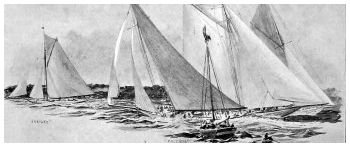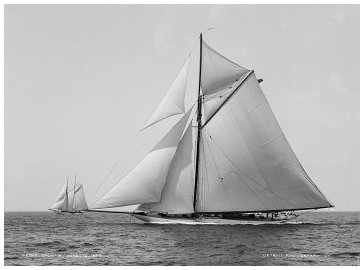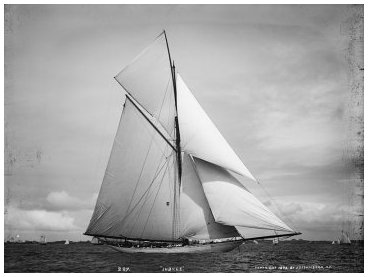Yves GARY Hits: 4824
Category: 1893 : CHALLENGE N°8
 Four candidates for one place
Four candidates for one placeThe four candidates for the honor of defending the cup met for the first time on the New York Yacht Club cruise. Little definite was learned here of their relative speed, owing to a succession of light, baffling winds, with fog, while on the first day of the cruise.
Vigilant, when pitted against Colonia in a good breeze off Glen Cove, in Long Island Sound, was disabled by carrying away her bowsprit and topmast, which accident put her out of the racing until repairs could be effected, taking several days.
Widespread interest was felt in the trial races to determine which of the four vessels should be selected to defend the cup. A quarter of a million dollars would not cover the outlay for these four boats. New types were being tested, and designers were departing from the traditions of the past.
Records of races sailing before the trial races for Defender |
||||||||||||||||||||||||||||||||||||||||||||||||||||||||||||||||||||||||||||||||||||||||||||||||||||||||||||||||||||||||||||||||||||||||||||||||||
|
|
|
||||||||||||||||||||||||||||||||||||||||||||||||||||||||||||||||||||||||||||||||||||||||||||||||||||||||||||||||||||||||||||||||||||||||||||||||
 When the day arrived for the first trial race, September 7th, all eyes, therefore, were turned toward Sandy Hook. There was a brisk w ind and a smart sea that morning, promising a test of strength as well as of speed. The course was laid S. by E., fifteen miles to windward for the first half, and to leeward returning. Unfortunately neither of the Boston boats was able to race, both being obliged to withdraw by accidents. Pilgrim carried away the jaws of her gaff — a hollow iron contrivance much too light to stand the strain put on it — and was obliged to withdraw before the start. Jubilee was put out of the race by the breaking of a peak-halyard block. Her blocks were of aluminum, and were far too light.
When the day arrived for the first trial race, September 7th, all eyes, therefore, were turned toward Sandy Hook. There was a brisk w ind and a smart sea that morning, promising a test of strength as well as of speed. The course was laid S. by E., fifteen miles to windward for the first half, and to leeward returning. Unfortunately neither of the Boston boats was able to race, both being obliged to withdraw by accidents. Pilgrim carried away the jaws of her gaff — a hollow iron contrivance much too light to stand the strain put on it — and was obliged to withdraw before the start. Jubilee was put out of the race by the breaking of a peak-halyard block. Her blocks were of aluminum, and were far too light.
With the race between Colonia and Vigilant, the test was of vessels of different lines from the hands of the same designer. From the start the two boats seemed to foot equally well, though it was apparent Vigilant held up to the wind better than her keel opponent. To the outward mark Vigilant beat Colonia by 1 m. 36 s. On the run home Colonia gained 1 m. 22 s., being beaten 14 s. actual time, but as she received an allowance of 20 s., she won by 6 s. corrected time. A re-measurement of Vigilant having been made, it was found she allowed Colonia but 14 s. This made the race a dead heat.
The summary :


 The second trial was sailed September 9th, in a moderate sailing breeze from E. S. E. The course was a triangle, ten miles to a leg, the first leg to windward. The Boston boats had made repairs, and were at the line to start, Pilgrim with substantial jaws of wood on her gaff. The day was warm and delightful, and many excursion steamers were out with parties enthusiastic over the races. The wind held light all day, and the sea was smooth. The race was therefore a test of light-weather qualities only. The fin-keel boats developed less speed under such conditions than had been predicted for them by their advocates. Colonia on this occasion displayed a trait which was to disqualify her as a successful single-sticker.
The second trial was sailed September 9th, in a moderate sailing breeze from E. S. E. The course was a triangle, ten miles to a leg, the first leg to windward. The Boston boats had made repairs, and were at the line to start, Pilgrim with substantial jaws of wood on her gaff. The day was warm and delightful, and many excursion steamers were out with parties enthusiastic over the races. The wind held light all day, and the sea was smooth. The race was therefore a test of light-weather qualities only. The fin-keel boats developed less speed under such conditions than had been predicted for them by their advocates. Colonia on this occasion displayed a trait which was to disqualify her as a successful single-sticker.

 She sagged off to leeward badly, showing that her design was faulty for windward work. This defect was not unlike that of Thistle, though more pronounced, and was caused by too little depth, and consequently too small an area of lateral plane. Vigilant, on the other hand, showed herself able to hold up as well in light as in strong winds, and developed the greatest speed of the four, though slow in stays, owing to the flatness of her keel, and its sharp forward end.
She sagged off to leeward badly, showing that her design was faulty for windward work. This defect was not unlike that of Thistle, though more pronounced, and was caused by too little depth, and consequently too small an area of lateral plane. Vigilant, on the other hand, showed herself able to hold up as well in light as in strong winds, and developed the greatest speed of the four, though slow in stays, owing to the flatness of her keel, and its sharp forward end.
The time of the races was not fast, as the following summary shows:

Vigilant's actual starting time being 11.32.13, she lost the 13 s. after 11.32, the time of the handicap gun. Vigilant's racing length was 96.48 feet, Colonia's 96.26, Jubilee's 95.48, and Pilgrim's 94.45. Vigilant therefore allowed Colonia 14 s., Jubilee 37 s., and Pilgrim 1 m. 36 s. She beat Colonia 12 m. 24 s., Jubilee 4 m. 38 s., and Pilgrim 8 m. 9 s., on corrected time.
These figures are worthy of analysis, as they are the record of the only race in which these four boats sailed under even conditions. Had it not been for bad luck in a bout of jockeying in passing the first mark, it is probable Jubilee would have made a better showing, as she led to near the mark, and lost nearly three minutes in turning.
 The third and last trial race was sailed September 11th. The course was fifteen miles to windward from Scotland light-vessel, the wind strong from the east, with a lively sea on. The start was at 11.40, handicap at 11.42. Misfortune followed Jubilee. About two minutes before the start her gaff jumped clear of the mast, and sprung to one side, the port jaw being broken. Any sailor knows what an exasperating species of mishap this is. Gen. Paine was determined to sail the boat if he could keep her canvas aloft, and while still making repairs crossed the line, 7 m. and 6 s. behind the handicap gun, and about 9 m. behind Vigilant and Colonia, which were threshing to windward by themselves. Pilgrim had showed freakishness in steering, and at the starting line was over toward the New Jersey shore. She was brought to the line 6 m. 6 s. behind the handicap gun, and but one minute ahead of Jubilee.
The third and last trial race was sailed September 11th. The course was fifteen miles to windward from Scotland light-vessel, the wind strong from the east, with a lively sea on. The start was at 11.40, handicap at 11.42. Misfortune followed Jubilee. About two minutes before the start her gaff jumped clear of the mast, and sprung to one side, the port jaw being broken. Any sailor knows what an exasperating species of mishap this is. Gen. Paine was determined to sail the boat if he could keep her canvas aloft, and while still making repairs crossed the line, 7 m. and 6 s. behind the handicap gun, and about 9 m. behind Vigilant and Colonia, which were threshing to windward by themselves. Pilgrim had showed freakishness in steering, and at the starting line was over toward the New Jersey shore. She was brought to the line 6 m. 6 s. behind the handicap gun, and but one minute ahead of Jubilee.
Jubilee sailed the entire race with the luff of her sail puckered, and her gaff sticking out past the mast like a bone from a broken wing. On the beat to the outer mark her jib-halyards gave way, and the sail came down on the run. This had not been long repaired when the forestaysail block gave out, though the sail did not come down. In spite of these accidents the boat made good time, and would without doubt have been very near the head of the fleet, if not actual winner of the race, had everything held aloft.
The official summary of the race was as follows:

Vigilant allowed Colonia 14 s., Pilgrim 1 m. 36 s. and Jubilee 37 s.
Vigilant's elapsed time to the first mark was 2 h. 31 m. 33 s.; Colonia's, 2 h. 38 m. 35 s. ; Jubilee's, 2 h. 36 m. 35 s.; and Pilgrim's 2 h. 51 m. 44 s.
It will be seen therefore that though disabled Jubilee was second best boat, in actual time, in the fifteen-mile beat, and was beaten only five minutes by the leader. The result of the race showed that Vigilant beat Colonia 6 m. 43 s., Jubilee (actual) 8 m. 19 s., and Pilgrim (actual) 29 m. 39 s.
 Published: Sept. 12, 1893 |
HOW THE RACE WAS SAILED. |
The race demonstrated that for cup defence Vigilant was without question the best boat. Colonia proved fast, but her unfortunate tendency to slide off to leeward was permanent. Pilgrim was fast on some points of sailing, but her canoe-shaped body, of small displacement, combined with her deep fin, which was too long, and was found to be flexible, so that it buckled when she was on the wind, left something to be desired in underbody form, and made her unreliable. She sailed well on a straight line, but owing to the length of her fin, she did not always mind her helm. Jubilee's gear aloft was too light. Properly rigged and tried, she would have developed greater speed.
 Published: Sept. 12, 1893 |
THE VIGILANT IS CHOSEN; SHE FAIRLY EARNS THE HONOR TO DEFEND THE AMERICA'S CUP. |
Results of trial races for the Defender |
||||||||||||||||||||||||||||||||||||||||||||||||||||||||||||||||||
|
|
|
||||||||||||||||||||||||||||||||||||||||||||||||||||||||||||||||
Vigilant was selected immediately after the third trial race to defend the cup. The other boats necessarily withdrew from racing.
Colonia was subsequently altered in her underbody, rigged as a schooner, and renamed Corona. She made a fast and handsome schooner, and was flagship of Commodore L. Cass Ledyard of the New York Yacht Club in 1901-02.
Jubilee was laid up after the trial races, at Lawley's Basin, South Boston, an object of speculation as to what she might have done with better luck.
Pilgrim was converted into a steam yacht, her fin being removed and keel and skeg put on. She is now the property of L. G. Bumham, Esqr., of Boston.
